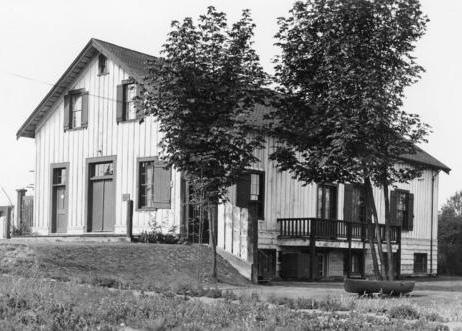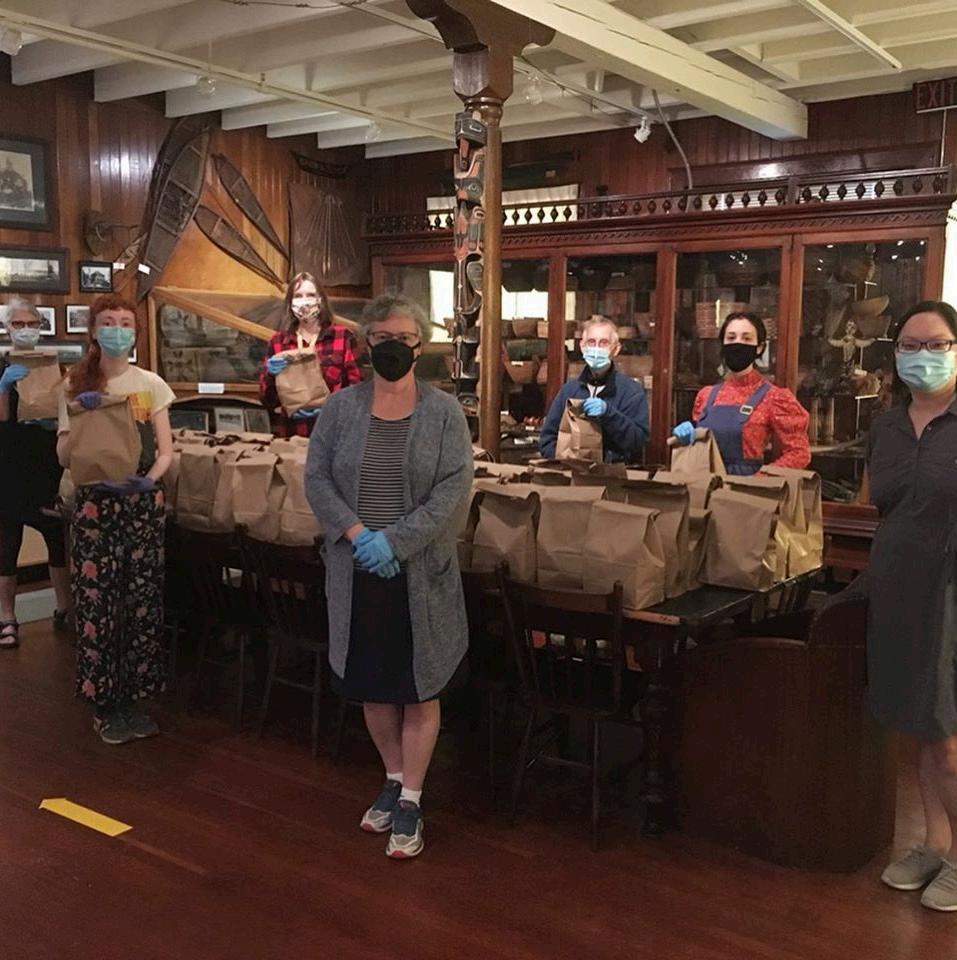
7 minute read
Lunch With Owl: Lisa Smith
Interviewed by Lindsay Foreman. Managing Editor: Roundup Magazine
Corresponding Secretary, Old Hastings Mill Store Museum, Vancouver, B.C.
Advertisement
How did you get involved with the Old Hastings Mill Store Museum and why? Can you share about the development of the museum and its mission?
It was meant to be! About 10 years ago, I attended a speaker night at the museum with author Chuck Davis presenting 100 Things You Didn’t Know About Vancouver. After the lecture, I started talking to some of the members of the Native Daughters of British Columbia, who operate the museum. I was told that a volunteer shift would be “about one day every six weeks.” I figured that I could handle that, so I proceeded with my membership to the lodge and also became a member of The Friends of the Old Hastings Mill Store Museum. The “one day every six weeks” became a lot more, but I’ve never regretted joining.
I’ve volunteered with the museum in various executive roles, including Historian, Chaplain, and at present, Corresponding Secretary. I also organize and lead group tours, and maintain a monthly museum blog and newsletter.
Can you share about the development of the museum and its mission?
The Old Hastings Mill Store dates to circa 1868, and served the Burrard Inlet sawmilling community of Stamp’s Mill (later known as Hastings Mill) as a general supply store, post office, and community gathering place. It narrowly escaped destruction during the Great Vancouver Fire of 1886.
When the Vancouver harbourfront was slated for redevelopment in the late 1920s, the store, which was facing demolition, was rescued by the Native Daughters of B.C. Post #1. The Vancouver Harbour Commission gave the store to the Native Daughters free of charge, on the condition that they finance its relocation. On July 29, 1930, the store was barged to a plot of land the Native Daughters had leased a few years earlier at the north foot of Alma Road in Point Grey (i.e., the current lease is up for renewal in 2024).
During a whirlwind, two-week campaign, the Native Daughters raised approximately $5,000, about half of the projected amount needed to restore the building. They also received many in-kind donations of construction materials and labour. Captain Charles Cates Sr. donated the $90 cost of the barging.

The Old Hastings Mill Store Museum, 2020.
Old Hastings Mill Store Museum.
Over the next year and a half, the store was refurbished with new interior wood paneling, support pillars, new flooring, a fireplace, staircases, and a basement caretaker’s suite. More recent upkeep measures have included a new roof (1986), an access route for mobility devices, a new fire escape, a chimney replacement, sprinkler system, electrical and security upgrades, and further renovation of the caretaker’s suite.
Our ongoing mission is to continue preserving Vancouver’s oldest building and its collection of items and belongings for guests to enjoy. The museum continues to be a community gathering place, where individuals of diverse backgrounds come together to learn, create, and appreciate. Little has changed over the years since the Native Daughters began to accumulate and display items. The museum is entirely owned and run by volunteers and we are constantly soliciting professional expertise in maintaining the building and its contents.
We will leave no stone unturned in seeking out additional sources of funding to continue with much-needed building restoration work. Exterior structural repairs to rotting shutters and other features are urgently required. The entire structure needs a fresh coat of paint to mitigate rot. We recently received a grant to install more advanced exterior security cameras to help safeguard the building and its collection.

Exterior of Hastings Mill Store Museum, 1575 Alma Street.
City of Vancouver Archives.
How is the museum reconciling the extreme colonial resource overexploitation, displacement, and multitude of injustices it represents within the traditional, ancestral, and unceded territory of the Sḵwx̱wú7mesh Úxwumixw (Squamish), səlilwətaɁɬ (Tsleil-Waututh) and xʷməθkʷəy̓əm (Musqueam) Nations?
Old Hastings Mill Store Museum is inextricably tied to colonialism. We cannot change that reality but we hope to emphasize that there was also positive interaction between cultures despite the atrocities brought on by colonialism. We are committed to ensuring that the heritage of our Indigenous host nations is well-represented at the museum.
Our recently-received 2020 City of Vancouver Community Arts Grant will be used to hire Indigenous curators-inresidence, who will facilitate improved signage of Indigenous belongings and provide interpretive services for museum guests during our 2021 season, COVID protocols permitting. We have added a Reconciliation Statement to our website, and routinely acknowledge that the museum stands on the traditional territory of the Squamish, Tsleil-Waututh, and Musqueam Nations.
Indigenous presenters have hosted many museum events in recent years, sharing their knowledge on topics such as basketry, Coast Salish weaving, and Kanaka Ranch. On June 16, 2018, Marissa Nahanee sang “The Paddle Song” outside the museum and received a formal declaration of gratitude for rescue efforts provided by Squamish residents from the North Shore’s Mission Reserve during the Great Vancouver Fire.
Volunteers preparing food packages for Steeves Manor residents during the COVID-19 pandemic, 2020. Photo credit: Old Hastings Mill Store Museum.
How has the COVID-19 pandemic affected the operation and maintenance of the museum?
COVID was part of the ‘perfect storm’ we found ourselves in this past year. It began at the same time we were facing many unforeseen challenges. Our long-time resident caretakers retired and we had proceeded with expensive maintenance projects in the vacated caretaker's suite. Cost over-runs on the construction of a new fire escape (built to meet current City safety standards) and drainage repairs had drastically depleted our cash reserves.

Volunteers preparing food packages for Steeves Manor residents during the COVID-19 pandemic, 2020.
Old Hastings Mill Store Museum.
We received over $37,000 in donations to save Old Hastings Mill Store Museum through our Go Fund Me Campaign. The coverage from local media outlets contributed greatly to the cause and the total exceeded our wildest dreams. We have placed the funds in a trust account, which will ensure that basic operational expenditures can be covered until February of 2022, if no additional funding sources are available.
The museum was closed in compliance with provincial health orders not long after we had opened for our 2020 season and all planned programming was cancelled. We re-opened our doors in June with COVID safety protocols in place. While we lost our traditional business from overseas tourists, we saw a notable rise in ‘staycation’ visitors over the balance of the season.
We recently opted to close our doors for the remaining five days of our shoulder season in response to the new provincial health orders and worsening case numbers. We are hopeful that the anticipated mass distribution of a COVID vaccine in forthcoming months will enable us to resume normal operations in 2021 and beyond.
You are a writer and are just finishing up your fourth book with Ronsdale Press. Can you share a bit about how you started your historical research and writing?
Over the past decade, and with my increased involvement with the museum, my interest in local history also greatly expanded. I’ve spent a great deal of time at the Vancouver Public Library and the City of Vancouver Archives sifting through the City’s history. I first co-authored Our Friend Joe: The Joe Fortes Story (Vancouver: Ronsdale Press, 2012) with Barbara Rogers. Next, I researched and published Vancouver is Ashes: The Great Fire of 1886 (Vancouver: Ronsdale Press, 2014), followed by Emily Patterson: The Heroic Life of a Milltown Nurse (Vancouver: Ronsdale Press, 2017). My forthcoming book, Hastings Mill: The Historic Times of a Vancouver Community, will be released this spring, again by Ronsdale Press. I’m pleased to say that all net proceeds of this book will benefit museum upkeep.
I also really enjoy sharing history with children. I was involved with the Museum of Vancouver education programming department for 13 or 14 years. In fact, my writing career started in 2001 with Travels with St. Roch: A Book for Kids, illustrated by Edward Knight and self-published as a fundraiser for the Vancouver Maritime Museum’s St. Roch Preservation Campaign.
Resources
hastingsmillmuseum.ca
Angela Fama, Inside Vancouver’s Oldest Building, the Old Hastings Mill Store Museum, Now in Danger of Closing, Montecristo Magazine, June 26, 2020.
Global News, The Old Hastings Mill Store’ in financial jeopardy, June 18, 2020.
Kenneth Chan, Crowdfunding campaign launched for museum at Vancouver's oldest building, Daily Hive Vancouver, June 16, 2020.
CBC, Paddle Song performed to thank Indigenous responders to Great Vancouver fire, June 16, 2018.
John Mackie, First Nations' heroics in 1886 to be celebrated at Great Fire event, Vancouver Sun, June 13, 2018.










